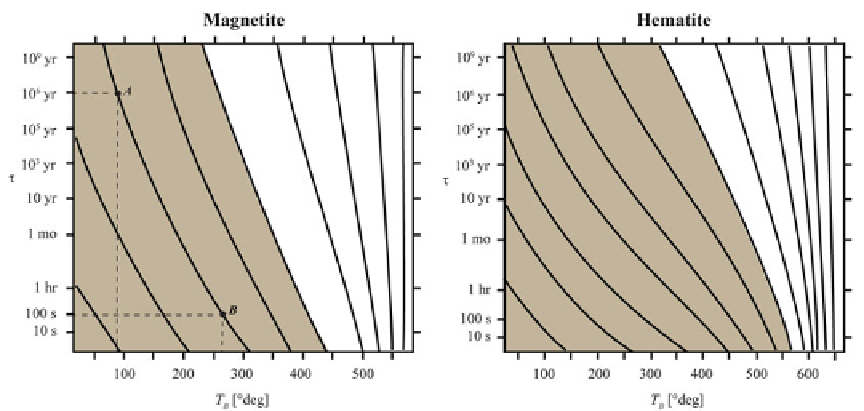Geology Reference
In-Depth Information
Fig. 6.4
Relation between blocking temperature,
T
B
, and relaxation time,
£
, for magnetite and hematite. A
line
on these
diagrams represents a set of pairs (
£
,
T
) that resets the TRM of an SD assemblage (Redrawn from Pullaiah et al. (
1975
))
1 Myr (point
A
in Fig.
6.4
). However, if we heat
the sample to 270
ı
C for 100 s in a zero magnetic
field, then this secondary magnetization is un-
blocked and reset to zero (point
B
in Fig.
6.4
).
We also note that grain assemblages associated
with curves that are placed on the right side
of the diagrams (high unblocking temperatures)
are reset by a small increase of temperature.
This is a consequence of the rapid increase of
£ for decreasing
T
when the assemblage has
T
B
close to the Curie temperature. Therefore,
grain assemblages in the grey regions of Fig.
6.4
,
which acquire VRM at relatively low tempera-
tures (250-350
ı
C) over geological time intervals
(
10 Myrs), are unstable carriers of primary
TRM. Conversely, grains in the white regions
of Fig.
6.4
have blocking temperatures within
100
ı
Cof
T
c
for any relaxation time, so that
T
B
is insensitive to £ and resetting their TRM
is more difficult. These grain assemblages are
the main carriers of primary TRM. The plots in
Fig.
6.4
predict that primary TRM can be retained
after a heating episode within the greenschist
metamorphic range (300-500
ı
C) but not within
the amphibolite range (above 550
ı
C).
6.3
Paleomagnetic Directions
The result of paleomagnetic sampling and
the subsequent laboratory treatment is a set
of
N
magnetization vectors (
M
1
,
M
2
, :::,
M
N
)
for a rock unit of known radiometric or
stratigraphic age. In plate tectonics, we are
generally interested only in the
paleomagnetic
directions
, and not in the magnitude of these
vectors. Therefore, the data set is usually
expressed in terms of
N
pairs (
I
k
,
D
k
) in a local
reference frame,
I
k
being the inclination of the
k
-th magnetization vector and
D
k
being its
declination. Paleomagnetic directions observed at
a single site are generally scattered, for example
as a consequence of inaccurate orientation
of the specimens. However, such within-site
scattering is flanked by an inter-site dispersion,
associated with the secular variation of the
sampling procedures are designed in such a
way that the samples of a single site have
approximately the same age, so that variations
of magnetization between the different sites of a


